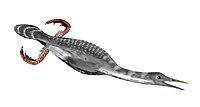Kanguk Formation
 From Wikipedia - Reading time: 4 min
From Wikipedia - Reading time: 4 min
| Kanguk Formation | |
|---|---|
| Stratigraphic range: Cenomanian-Maastrichtian ~ | |
| Type | Geological formation |
| Sub-units | Eglinton Member |
| Underlies | Eureka Sound Formation |
| Overlies | Hassel Formation |
| Thickness | up to 365 metres (1,200 ft)[1] |
| Lithology | |
| Primary | Shale, siltstone |
| Other | Sandstone, tuff |
| Location | |
| Coordinates | 79°14′24″N 92°21′58″W / 79.24°N 92.36613°W |
| Region | Northwest Territories, Nunavut |
| Country | |
| Type section | |
| Named for | Kanguk Peninsula |
| Named by | Souther |
| Year defined | 1963 |
The Kanguk Formation is a geological formation in the Northwest Territories and Nunavut, Canada whose strata date back to the Late Cretaceous. Dinosaur remains are among the fossils that have been recovered from the formation.[2]
It was first described in the Kanguk Peninsula of the Axel Heiberg Island, along the shore of the Stand Fiord by Souther in 1963.[3] The formation occurs throughout the Sverdrup Basin and the southern Queen Elizabeth Islands.
Lithology
[edit]The Kanguk Formation is composed of dark shale and siltstone with interbeds of sandstone, bentonite and tuff.[1] Thicker sandstone and conglomerate beds occur in the western reaches in Eglinton Island.
Fossil content
[edit]The Kanguk Formation preserves an extensive record of shelf assemblages rich in benthic foraminifera that reveal numerous pulses of local hypoxia.[4]
| Dinosaurs of the Kanguk Formation | ||||||
|---|---|---|---|---|---|---|
| Genus | Species | Location | Stratigraphic position | Abundance | Description | Images |
| Canadaga | C. arctica | A Hesperomithes | ||||
| Hesperornis[2] | Indeterminate[2] |  | ||||
| Hadrosauridae[5] | Indeterminate | |||||
| Lambeosaurinae[6] | Indeterminate | |||||
| Tyrannosauroidea[6] | Indeterminate | |||||
| Ornithomimidae[7] | Indeterminate | |||||
See also
[edit]References
[edit]- ^ a b Lexicon of Canadian Geological Units. "Kanguk Formation". Retrieved 2009-03-07.
- ^ a b c Weishampel, David B; et al. (2004). "Dinosaur distribution (Late Cretaceous, North America)." In: Weishampel, David B.; Dodson, Peter; and Osmólska, Halszka (eds.): The Dinosauria, 2nd, Berkeley: University of California Press. Pp. 574-588. ISBN 0-520-24209-2.
- ^ Geological Survey of Canada Map 36-1959
- ^ Schröder-Adams, Claudia J.; Herrle, Jens O.; Embry, Ashton F.; Haggart, James W.; Galloway, Jennifer M.; Pugh, Adam T.; Harwood, David M. (1 November 2014). "Aptian to Santonian foraminiferal biostratigraphy and paleoenvironmental change in the Sverdrup Basin as revealed at Glacier Fiord, Axel Heiberg Island, Canadian Arctic Archipelago". Palaeogeography, Palaeoclimatology, Palaeoecology. 413: 81–100. Bibcode:2014PPP...413...81S. doi:10.1016/j.palaeo.2014.03.010. Retrieved 6 November 2022.
- ^ Vavrek, Matthew J.; Hills, Len V.; Currie, Philip J. (2014-03-18). "A Hadrosaurid (Dinosauria: Ornithischia) from the Late Cretaceous (Campanian) Kanguk Formation of Axel Heiberg Island, Nunavut, Canada, and Its Ecological and Geographical Implications". Arctic. 67 (1): 1–9–1–9. doi:10.14430/arctic4362. ISSN 1923-1245.
- ^ a b Brownstein, Chase D. (2018-02-08). "The biogeography and ecology of the Cretaceous non-avian dinosaurs of Appalachia". Palaeontologia Electronica. 21 (1): 1–56. doi:10.26879/801. ISSN 1094-8074.
- ^ McFeeters, B. (2015). "Evolution and Diversity of Ornithomimid Dinosaurs in the Upper Cretaceous Belly River Group of Alberta" (PDF). Ottawa, Ontario, Canada: Carleton University. pp. 1–253.
Further reading
[edit]- A. T. Pugh, C. J. Schröder-Adams, E. S. Carter, J. OHerrle, J. Galloway, J. W. Haggart, J. L. Andrews and K. Hatsukanoc. 2014. Cenomanian to Santonian radiolarian biostratigraphy, carbon isotope stratigraphy and paleoenvironments of the Sverdrup Basin, Ellef Ringnes Island, Nunavut, Canada. Palaeogeography, Palaeoclimatology, Palaeoecology 413:101-122
- J. A. Tarduno, D. B. Brinkman, P. R. Renne, R. D. Cottrell, H. Scher and P. Castillo. 1998. Evidence for extreme climatic warmth from Late Cretaceous Arctic vertebrates. Science 282:2241-2244
 KSF
KSF